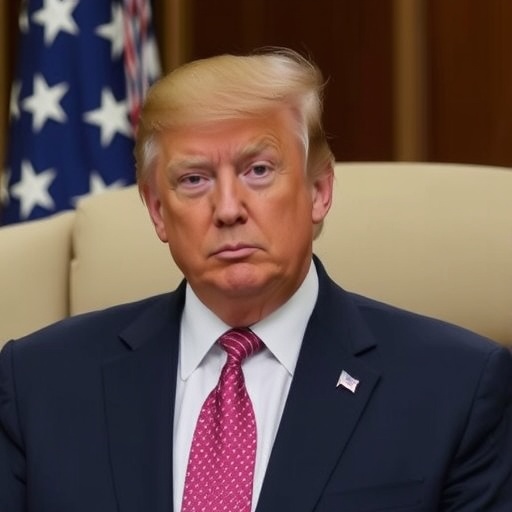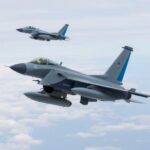Trump Seeks China’s Assistance in Russia Peace Deal During High-Stakes Asia Trip
In a bold diplomatic maneuver, President Donald Trump has publicly called on China to play a pivotal role in brokering a Russia peace deal as he launches a five-day tour across Asia, amid escalating tensions over the Ukraine conflict. Speaking to reporters before departing Washington, Trump emphasized the need for Beijing’s influence to pressure Moscow into negotiations, signaling a potential shift in U.S. foreign policy that could reshape global alliances. This announcement comes at a critical juncture, with the Ukraine war entering its third year and economic ripples affecting markets worldwide.
- Trump’s Asia Tour: Navigating Trade and Security in Malaysia, Japan, and South Korea
- Ukraine’s War-Torn Landscape: The Stakes in Trump’s Push for a Russia Peace Deal
- Spotlight on the Trump-Xi Summit: Agenda and Diplomatic Intricacies
- Global Echoes: Reactions to Trump’s China Outreach on Russia and Ukraine
Trump’s outreach to China underscores the complexities of international relations in 2024, where traditional adversaries might become unlikely partners in pursuit of stability. The president’s itinerary includes stops in Malaysia, Japan, and South Korea, culminating in a high-profile summit with Xi Jinping in Seoul. During this meeting, expected later this week, Trump aims to discuss not only the Russia peace deal but also trade imbalances and regional security concerns. Analysts suggest this could be a game-changer, given China’s economic leverage over Russia and its neutral stance on the Ukraine invasion.
The timing of Trump’s statement is no coincidence. Recent intelligence reports indicate that Russian forces have intensified operations in eastern Ukraine, prompting urgent calls for de-escalation from NATO allies. Trump, who has long advocated for direct talks with adversaries, sees China as a key mediator due to its close ties with Vladimir Putin. “We need China’s help to bring Russia to the table on Ukraine,” Trump declared, adding that failure to act could lead to “unnecessary prolongation of suffering.” This approach has sparked debate, with some praising the pragmatism and others warning of concessions to authoritarian regimes.
Historical context adds depth to this development. Trump’s first term saw strained U.S.-China relations, marked by trade wars and accusations of intellectual property theft. Yet, his administration also pursued dialogues on North Korea, hinting at a pattern of engaging Beijing on thorniest issues. Now, with the Ukraine crisis straining global resources—over 500,000 casualties reported by the United Nations and energy prices surging 40% in Europe—Trump’s strategy appears aimed at leveraging Xi Jinping‘s authority to influence outcomes.
Trump’s Asia Tour: Navigating Trade and Security in Malaysia, Japan, and South Korea
President Trump‘s five-day Asia trip is packed with bilateral meetings designed to address multifaceted challenges, starting with Malaysia, a nation pivotal in Southeast Asian supply chains. Upon arrival in Kuala Lumpur, Trump is scheduled to meet Prime Minister Anwar Ibrahim to discuss enhancing U.S. investments in semiconductors and renewable energy, sectors where Malaysia has emerged as a hub amid U.S.-China tech rivalries. This stop is particularly timely, as the U.S. seeks to diversify away from Chinese dominance in critical minerals essential for electric vehicles and defense tech.
Moving to Japan, Trump will engage with Prime Minister Fumio Kishida in Tokyo, focusing on bolstering the U.S.-Japan alliance against potential threats from North Korea and regional assertiveness by China. Discussions are expected to cover joint military exercises and economic pacts, with Japan committing an additional $10 billion to U.S. defense initiatives last year. The agenda also touches on the Russia peace deal, as Japan has its own territorial disputes with Moscow over the Kuril Islands, making Tokyo a natural ally in pressuring Russia.
The tour’s crescendo occurs in South Korea, where Trump will address the National Assembly before his rendezvous with Xi Jinping. Seoul’s strategic importance cannot be overstated; as home to 28,000 U.S. troops, it’s a frontline in the Indo-Pacific strategy. President Yoon Suk Yeol has prioritized stronger ties with Washington, including a recent trilateral summit with Japan. Here, Trump plans to announce expanded cooperation on AI and quantum computing, while subtly weaving in the Ukraine angle to garner Asian support for the Russia peace deal.
Throughout the trip, Trump is accompanied by key advisors, including Secretary of State Antony Blinken and National Security Advisor Jake Sullivan, who have been instrumental in shaping this diplomatic push. Weather permitting, public events in each capital will allow Trump to rally support for his vision of “peace through strength,” a phrase echoing his campaign rhetoric. Economists predict these visits could unlock $50 billion in new trade deals, blending economic incentives with geopolitical goals.
Ukraine’s War-Torn Landscape: The Stakes in Trump’s Push for a Russia Peace Deal
The Ukraine conflict, now a protracted humanitarian disaster, forms the urgent backdrop to Trump‘s appeal for China‘s involvement. Since Russia’s full-scale invasion in February 2022, the war has displaced over 6 million people and caused widespread devastation, with cities like Kharkiv and Mariupol reduced to rubble. Ukrainian President Volodymyr Zelenskyy has repeatedly urged international mediation, but stalled talks in Geneva and Istanbul have highlighted the need for fresh approaches.
Russia‘s economy, battered by Western sanctions, relies heavily on China for exports—bilateral trade hit $240 billion in 2023, up 26% from the previous year. Beijing’s purchase of discounted Russian oil has effectively underwritten the Kremlin’s war machine, making Xi Jinping a figure of immense leverage. Trump‘s strategy posits that China could use this economic clout to encourage Putin to withdraw from occupied territories, potentially averting a broader NATO-Russia confrontation.
Statistics paint a grim picture: The World Bank estimates Ukraine’s reconstruction costs at $486 billion over the next decade, while global food prices have risen 20% due to disrupted Black Sea exports. In Europe, energy security remains precarious, with Germany reactivating coal plants to offset lost Russian gas. Trump, drawing from his real estate background, has likened the situation to a “bad deal that needs renegotiation,” advocating for a ceasefire that includes security guarantees for Ukraine without full NATO membership—a concession that irks Kyiv but appeals to Moscow.
Expert voices underscore the risks. Fiona Hill, former U.S. National Security Council official, noted in a recent CNN interview, “Engaging China on Russia could normalize aggression if not handled carefully.” Conversely, Graham Allison, author of “Destined for War,” argues that Xi Jinping‘s aversion to global instability—given China’s economic vulnerabilities—might make Beijing amenable to a Russia peace deal. On the ground in Ukraine, civilians like those in Kyiv’s bomb shelters express cautious hope, with one resident telling Reuters, “Any path to peace is welcome, even if it involves powers we don’t trust.”
This diplomatic gambit also intersects with domestic U.S. politics. With midterm elections looming, Trump‘s focus on ending foreign entanglements resonates with his base, who view endless wars as fiscal drains—U.S. aid to Ukraine has exceeded $75 billion since 2022. Yet, critics in Congress, including Senator Lindsey Graham, warn that sidelining Europe could fracture alliances, potentially emboldening adversaries like Iran and North Korea.
Spotlight on the Trump-Xi Summit: Agenda and Diplomatic Intricacies
The marquee event of Trump‘s trip is his meeting with Xi Jinping in South Korea, a neutral venue chosen to symbolize balanced diplomacy. Set for Thursday in Seoul’s Blue House, the summit will last approximately two hours, followed by a working lunch. Protocol demands careful choreography; past U.S.-China encounters, like the 2017 Mar-a-Lago talks, blended formality with candid exchanges on thorny issues.
At the forefront is the Russia peace deal, where Trump will reportedly present a framework involving phased Russian troop withdrawals from Ukraine in exchange for lifted sanctions and economic aid packages. Xi Jinping, who met Putin in Moscow just last month, holds sway through initiatives like the Belt and Road, which includes Russian infrastructure projects. Sources close to the White House indicate Trump may offer incentives, such as eased tariffs on Chinese goods, to sweeten the deal.
Beyond Ukraine, the agenda encompasses trade disputes—U.S. tariffs on $300 billion of Chinese imports remain a flashpoint—and technology curbs, including restrictions on Huawei. China‘s growing military presence in the South China Sea will also feature, with Trump pushing for de-escalation to prevent accidental conflicts. A senior U.S. official, speaking anonymously, described the tone as “pragmatic but firm,” echoing Trump‘s deal-making ethos.
Historical parallels abound: Nixon’s 1972 visit to China opened doors to détente with the Soviet Union, a precedent Trump might invoke. Yet, challenges persist; Xi Jinping‘s domestic priorities, including economic recovery post-COVID, could limit concessions. Live coverage from the summit, beamed via satellite to global audiences, will scrutinize body language and joint statements for clues on progress.
Global Echoes: Reactions to Trump’s China Outreach on Russia and Ukraine
Trump‘s overture has elicited a spectrum of responses worldwide, from cautious optimism in Asia to skepticism in Europe. In Brussels, EU foreign policy chief Josep Borrell expressed concerns that involving China might dilute Western unity, stating, “We must ensure any Russia peace deal upholds Ukraine’s sovereignty.” NATO Secretary-General Jens Stoltenberg echoed this, urging Trump to coordinate with allies before unilateral moves.
In Moscow, the Kremlin downplayed the initiative, with spokesman Dmitry Peskov telling TASS, “Russia negotiates on its terms, not Washington’s.” Putin, facing internal pressures from war fatigue, might view China‘s involvement as a lifeline, especially as Indian mediation efforts have faltered. Kyiv’s reaction is mixed; Zelenskyy welcomed external pressure on Russia but insisted on no territorial compromises, per a statement from his office.
Asian capitals are more receptive. Japan’s Kishida praised Trump‘s “bold vision,” while South Korea’s Yoon highlighted shared interests in stability. In Beijing, state media like Xinhua framed the summit as a “positive step,” subtly nodding to Xi Jinping‘s global leadership without committing. U.S. markets reacted bullishly, with the Dow Jones rising 1.2% on news of potential de-escalation, reflecting hopes for lower energy costs.
Civil society voices add nuance. Human Rights Watch cautioned against deals that ignore war crimes in Ukraine, citing over 10,000 documented civilian deaths. Think tanks like the Brookings Institution hosted panels debating the merits, with one expert quipping, “Trump‘s art of the deal meets Xi‘s long game.”
Looking ahead, the summit’s outcomes could redefine U.S.-China ties, potentially paving the way for a multilateral forum on Ukraine involving the UN and G20. If successful, a Russia peace deal might stabilize supply chains, reduce inflation pressures, and allow Trump to pivot to domestic priorities like infrastructure. Failure, however, risks heightened tensions, with ripple effects from the Taiwan Strait to the Arctic. As Trump jets across Asia, the world watches whether this diplomatic odyssey yields breakthroughs or merely more rhetoric in the shadow of the Ukraine war.








